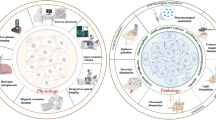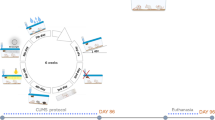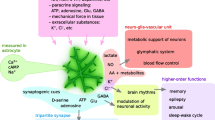Abstract
Noxious stimuli applied at doses close to but below the threshold of cell injury induce adaptive responses that provide a defense against additional stress. Epileptic preconditioning protects neurons against status epilepticus and ischemia; however, it is not known if the converse is true. During hypoxia/ischemia (H/I), lactate released from astrocytes is taken up by neurons and is stored for energy, a process mediated by monocarboxylate transporter 4 (MCT4) in astroglia. The present study investigated whether H/I preconditioning can provide protection to neurons against epilepsy through upregulation of MCT4 expression in astrocytes in vitro and in vivo. An oxygen/glucose deprivation protocol was used in primary astrocyte cultures, while rats were subjected to an intermittent hypoxia preconditioning (IHP) paradigm followed by lithium-pilocarpine-induced epilepsy as well as lactate transportation inhibitor injection, with a subsequent evaluation of protein expression as well as behavior. H/I induced an upregulation of MCT4 expression, while an IHP time course of 5 days provided the greatest protection against epileptic seizures, which was most apparent by 3 days after IHP. However, lactate transport function disturbances can block the protective effect induced by IHP. These findings provide a potential basis for the clinical treatment of epilepsy.








Similar content being viewed by others
References
Fisher RS, van Emde Boas W, Blume W, Elger C, Genton P, Lee P, Engel J Jr (2005) Epileptic seizures and epilepsy. Definitions proposed by the International League against Epilepsy (ILAE) and the International Bureau for Epilepsy (IBE). Epilepsia 46:470–472
Janoff A (1964) Alterations in lysosomes (intracellular enzymes) during shock; effects of preconditioning (tolerance) and protective drugs. Int Anesthesiol Clin 2:251–269
Kirino T (2002) Ischemic tolerance. J Cereb Blood Flow Metab 22:1283–1296
Plamondon H, Blondeau N, Heurteaux C, Lazdunski M (1999) Mutually protective actions of kainic acid epileptic preconditioning and sublethal global ischemia on hippocampal neuronal death: involvement of adenosine A1 receptors and KATP channels. J Cereb Blood Flow Metab 19:1296–1308
Cloix JF, Ardourel MY, Hévor T (2008) Glycogen metabolism and brain pathologies. Cent Nerv Syst Agents Med Chem 8:187–197
Brown AM, Baltan Tekkok S, Ransom BR (2004) Energy transfer from astrocytes to axons: the role of CNS glycogen. Neurochem Int 45:529–536
Pellerin L (2003) Lactate as a pivotal element in neuron-glia metabolic cooperation. Neurochem Int 43:331–338
Greene AE, Todorova MM, Seyfried TN (2003) Perspectives on the metabolic management of epilepsy through dietary reduction of glucose and elevation of ketone bodies. J Neurochem 86:529–537
Li X, Yokono K, Okada Y (2000) Phosphofructokinase, a glycolytic regulatory enzyme has a crucial role for maintenance of synaptic activity in guinea pig hippocampal slices. Neurosci Lett 294:81–84
Vielhaber S, Von Oertzen JH, Kudin AF, Schoenfeld A, Menzel C, Biersack HJ, Kral T, Elger CE, Kunz WS (2003) Correlation of hippocampal glucose oxidation capacity and interictal FDG-PET in temporal lobe epilepsy. Epilepsia 44:193–199
Pierre K, Pellerin L (2005) Monocarboxylate transporters in the central nervous system: distribution, regulation and function. J Neurochem 94:1–14
Simpson IA, Carruthers A, Vannucci SJ (2007) Supply and demand in cerebral energy metabolism: the role of nutrient transporters. J Cereb Blood Flow Metab 27:1766–1791
Halestrap AP, Meredith D (2004) The SLC16 gene family-from monocarboxylate transporters (MCTs) to aromatic amino acid transporters and beyond. Pflugers Arch 447:619–628
Lauritzen F, de Lanerolle NC, Lee TS, Spencer DD, Kim JH, Bergersen LH, Eid T (2011) Monocarboxylate transporter 1 is deficient on microvessels in the human epileptogenic hippocampus. Neurobiol Dis 41:577–584
Lauritzen F, Heuser K, de Lanerolle NC, Lee TS, Spencer DD, Kim JH, Gjedde A, Eid T, Bergersen LH (2012) Redistribution of monocarboxylate transporter 2 on the surface of astrocytes in the human epileptogenic hippocampus. Glia 60:1172–1181
Ullah MS, Davies AJ, Halestrap AP (2006) The plasma membrane lactate transporter MCT4, but not MCT1, is up-regulated by hypoxia through a HIF-1alpha-dependent mechanism. J Biol Chem 281:9030–9037
Sen E, Basu A, Willing LB, Uliasz TF, Myrkalo JL, Vannucci SJ, Hewett SJ, Levison SW (2011) Pre-conditioning induces the precocious differentiation of neonatal astrocytes to enhance their neuroprotective properties. ASN neuro 3:e00062
Nakagawa S, Deli MA, Kawaguchi H, Shimizudani T, Shimono T, Kittel A, Tanaka K, Niwa M (2009) A new blood-brain barrier model using primary rat brain endothelial cells, pericytes and astrocytes. Neurochem Int 54:253–263
Beetsch JW, Olson JE (1993) Taurine transport in rat astrocytes adapted to hyperosmotic conditions. Brain Res 613:10–15
Montana V, Ni Y, Sunjara V, Hua X, Parpura V (2004) Vesicular glutamate transporter-dependent glutamate release from astrocytes. J Neurosci 24:2633–2642
Huang XJ, Zhang WP, Li CT, Shi WZ, Fang SH, Lu YB, Chen Z, Wei EQ (2008) Activation of CysLT receptors induces astrocyte proliferation and death after oxygen–glucose deprivation. Glia 56:27–37
Williams RJ, Maus M, Stella N, Glowinski J, Premont J (1996) Reduced glucose metabolism enhances the glutamate-evoked release of arachidonic acid from striatal neurons. Neuroscience 74:461–468
Schneider U, Poole RC, Halestrap AP, Grafe P (1993) Lactate-proton co-transport and its contribution to interstitial acidification during hypoxia in isolated rat. Neuroscience 53:1153–1162
Barnard JP, Reynafarje B, Pedersen PL (1993) Glucose catabolism in African trypanosomes. Evidence that the terminal step is catalyzed by a pyruvate transporter capable of facilitating uptake of toxic analogs. J Biol Chem 268:3654–3661
Medina-Ceja L, Cordero-Romero A, Morales-Villagrán A (2008) Antiepileptic effect of carbenoxolone on seizures induced by 4-aminopyridine: a study in the rat hippocampus and entorhinal cortex. Brain Res 1187:74–81
Medina-Ceja L, Sandoval-García F, Morales-Villagrán A, López-Pérez SJ (2012) Rapid compensatory changes in the expression of EAAT-3 and GAT-1 transporters during seizures in cells of the CA1 and dentate gyrus. J Biomed Sci 19:78
Gao CJ, Niu L, Ren PC, Wang W, Zhu C, Li YQ, Chai W, Sun XD (2012) Hypoxic preconditioning attenuates global cerebral ischemic injury following asphyxial cardiac arrest through regulation of delta opioid receptor system. Neuroscience 202:352–362
Noshita N, Sugawara T, Hayashi T, Lewen A, Omar G, Chan PH (2002) Copper/zincsuperoxide dismutase attenuates neuronal cell death by preventing extracellular signal-regulated kinase activation after transient focal cerebral ischemia in mice. J Neurosci 22:7923–7930
Saito A, Hayashi T, Okuno S, Ferrand-Drake M, Chan PH (2003) Overexpression of copper/zinc superoxide dismutase in transgenic mice protects against neuronal cell death after transient focal ischemia by blocking activation of the Bad cell death signaling pathway. J Neurosci 23:1710–1718
Medina-Ceja L, Sandoval-García F, Pardo-Peña K (2011) Effect of early glutamate exposure on EAAT-3 and GAT-1 protein expression in cells of the dentate gyrus and CA1 region of the adult rat hippocampus. Arch Med Res 42:433–438
Turski L, Ikonomidou C, Turski WA, Bortolotto ZA, Cavalheiro EA (1989) Review: cholinergic mechanisms and epileptogenesis. The seizures induced by pilocarpine: a novel model of intractable epilepsy. Synapse 3:154–171
Zemke D, Smith JL, Reeves MJ, Majid A (2004) Ischemia and ischemic tolerance in the brain: an overview. Neurotoxicology 25:895–904
Dirnagl U, Meisel A (2008) Endogenous neuroprotection: mito-chondria as gateways to cerebral preconditioning? Neuropharmacology 55:334–344
Schaller B, Graf R (2002) Cerebral ischemic preconditioning. An experimental phenomenon or a clinical important entity of stroke prevention? J Neurol 249:1503–1511
Dirnagl U, Simon RP, Hallenbeck JM (2003) Ischemic tolerance and endogenous neuroprotection. Trends Neurosci 26:248–254
Pellerin L, Bonvento G, Chatton J, Pierre K, Magistretti PJ (2002) Role of neuron-glia interactions in brain energy metabolism: implications for neurodegenerative disorders. Diabetes Nutr Metab 15:268–273
Magistretti PJ (2006) Neuron-glia metabolic coupling and plasticity. J Exp Biol 209:2304–2311
Nedergaard M, Dirnagl U (2005) Role of glial cells in cerebral ischemia. Glia 50:281–286
Rosenberg PA, Aizenman E (1989) Hundred-fold increase in neuronal vulnerability to glutamate toxicity in astrocyte-poor cultures of rat cerebral cortex. Neurosci Lett 103:162–168
Wilson JX (1997) Antioxidant defense of the brain: a role for astrocytes. Can J Physiol Pharmacol 75:1149–1163
Dringen R, Gutterer JM, Hirrlinger J (2000) Glutathione metabolism in brain metabolic interaction between astrocytes and neurons in the defense against reactive oxygen species. Eur J Biochem 267:4912–4916
Wender R, Brown AM, Fern R, Swanson RA, Farrell K, Ransom BR (2000) Astrocytic glycogen influences axon function and survival during glucose deprivation in central white matter. J Neurosci 20:6804–6810
Anderson CM, Swanson RA (2000) Astrocyte glutamate transport: review of properties, regulation, and physiological functions. Glia 32:1–14
Voutsinos-Porche B, Bonvento G, Tanaka K, Steiner P, Welker E, Chatton JY, Magistretti PJ, Pellerin L (2003) Glial glutamate transporters mediate a functional metabolic crosstalk between neurons and astrocytes in the mouse developing cortex. Neuron 37:275–286
Gong SJ, Chen LY, Zhang M, Gong JX, Ma YX, Zhang JM, Wang YJ, Hu YY, Sun XC, Li WB, Zhang Y (2012) Intermittent hypobaric hypoxia preconditioning induced brain ischemic tolerance by up-regulating glial glutamate transporter-1 in rats. Neurochem Res 37:527–537
Domora´kova I, Mechı´rova E, Dankova M, Danielisova V, Burda J (2009) Effect of antioxidant treatment in global ischemia and ischemic postconditioning in the rat hippocampus. Cell Mol Neurobiol 29:37–44
Lin AMY, Chen CF, Ho TL (2002) Neuroprotective effect of intermittent hypoxia on iron-induced oxidative injury in rat brain. Exp Neurol 176:328–335
Andoh T, Lee SY, Chock B, Chiueh CC (2000) Preconditioning regulation of bcl-2 and p66shc by human NOS1 enhances tolerance to oxidative stress. FASEB J 14:44–46
Blondeau N, Widmann C, Lazdunski M, Heurteaux C (2001) Activation of the nuclear factor-kappaB is a key event in brain tolerance. J Neurosci 21:4668–4677
Emerson MR, Samson FE, Pazdernik TL (2000) Effect of hypoxia preconditioning on expression of metallothinein-1,2 and heme oxygenase-1 before and after kainic acid-induced seizures. Cell Mol Biol 46:19–26
Barone FC, White RF, Spera PA, Ellison J, Currie RW, Wang X, Feuerstein GZ (1998) Ischemic preconditioning and brain tolerance: temporal histological and functional outcomes, protein synthesis requirement, and interleukin-1 receptor antagonist and early gene expression. Stroke 9:1937–1951
Lauritzen F, Perez EL, Melillo ER, Roh JM, Zaveri HP, Lee TS, Wang Y, Bergersen LH, Eid T (2012) Altered expression of brain monocarboxylate transporter 1 in models of temporal lobe epilepsy. Neurobiol Dis 45:165–176
Rademakers SE, Lok J, van der Kogel AJ, Bussink J, Kaanders JH (2011) Metabolic markers in relation to hypoxia; staining patterns and colocalization of pimonidazole, HIF-1α, CAIX, LDH-5, GLUT-1, MCT1 and MCT4[J]. BMC Cancer 12:167
Pérez de Heredia F, Wood IS, Trayhurn P (2010) Hypoxia stimulates lactate release and modulates monocarboxylate transporter (MCT1, MCT2, and MCT4) expression in human adipocytes. Pflugers Arch 459:509–518
Sharp FR, Bernaudin M (2004) HIF1 and oxygen sensing in the brain. Nat Rev Neurosci 5:437–448
Wang GL, Semenza GL (1995) Purification and characterization of hypoxiainducible factor 1. J Biol Chem 270:1230–1237
Semenza GL, Jiang BH, Leung SW, Passantino R, Concordet JP, Maire P, Giallongo A (1996) Hypoxia response elements in aldolase A, enolase 1, and lactate dehydrogenase A gene promoters contain essential binding sites for hypoxia-inducible factor-1. J Biol Chem 271:32529–32537
Bergersen L, Waerhaug O, Helm J, Thomas M, Laake P et al (2001) A novel postsynaptic density protein: the monocarboxylate transporter MCT2 is colocalized with delta-glutamate receptors in postsynaptic densities of parallel fiber-Purkinje cell synapses. Exp Brain Res 136:523–534
Deitmer JW (2000) Glial strategy for metabolic shuttling and neuronal function. BioEssays 22:747–752
Acknowledgments
This work was supported by the National Natural Science Foundation of China (Grant No. 81271433). The authors thank Dr. Haiyan Zhou for help with the astrocyte primary culture; Yi Li and Lei Tao for help with the epilepsy protocol; and Xiaorong Jin and Kai Jiao for their contributions to this work.
Author information
Authors and Affiliations
Corresponding authors
Additional information
Chen Gao, Chao Wang and Bei Liu have contributed equally to this work.
Rights and permissions
About this article
Cite this article
Gao, C., Wang, C., Liu, B. et al. Intermittent Hypoxia Preconditioning-Induced Epileptic Tolerance by Upregulation of Monocarboxylate Transporter 4 Expression in Rat Hippocampal Astrocytes. Neurochem Res 39, 2160–2169 (2014). https://doi.org/10.1007/s11064-014-1411-2
Received:
Revised:
Accepted:
Published:
Issue Date:
DOI: https://doi.org/10.1007/s11064-014-1411-2




